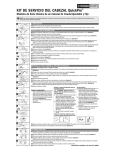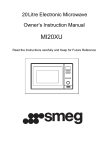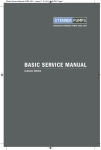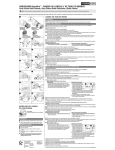Download QuickPro® PUMP HEAD REPLACEMENT
Transcript
QuickPro® PUMP HEAD REPLACEMENT for Single Head Adjustable & Fixed Output Pumps NOTICE: Before installing or servicing the pump, read the pump manual for all safety information and complete instructions. The pump is designed for installation and service by properly trained personnel. A B REMOVE AND INSTALL THE QuickPro® PUMP HEAD ➊ Turn off the pump and unplug the power cord. C D E F Adjustable Model a. To remove the pump head, hold the feed rate securely, grasp the head and turn it clockwise until it stops. Figure A b. Remove the head by pulling it straight out from the pump. The main shaft will come out with the pump head. c. Using a pair of pliers, grasp the main shaft and rock it back and forth (clockwise and counter-clockwise) while pulling it straight out of the pump head. Set aside the shaft to be reinstalled later. Discard the old tube, housing and cover. If the shaft will not come out, remove the cover from the pump head and use a hammer to tap the shaft from the front of the roller assembly to dislodge it. Figure B & C d. Insert the shaft back into the feed rate control. Figure D e. Put the new pump head onto the feed rate control and turn it counterclockwise until the shaft falls into place. Proceed to step 2. Fixed Output Model a. To remove the pump head, hold the pump securely, grasp the head and turn it clockwise until it stops. Figure A b. Remove the tube housing and roller assembly together by pulling it straight out from the pump. The shaft will remain in the pump. Discard the tube, housing and cover. If the housing and roller assembly are difficult to remove, insert a large, flat blade screwdriver between the pump body and the head. Gently pry the head forward, ensuring the rivets on the pump body remain disengaged from the tube housing. c. Put the new pump head onto the motor and turn it counterclockwise until the shaft falls into place. Figure E Proceed to step 2. ➋ Push the pump head in while turning it counterclockwise. Line up the rivet holes on the pump head with the rivets on the feed rate control (adjustable pump) OR motor (fixed output pump). Figure E ➌ Continue to push until the rivets are inside the holes. ➍ Turn the pump head counterclockwise to secure the rivets in the rivet slots, firmly attaching the pump head. EXPAND THE ROLLER ASSEMBLY ➊ On the adjustable model, ensure the feed rate control is set to 10. With the cover latched, plug the pump in and turn the power on. Allow the pump to run the roller assembly in its collapsed position for approximately one minute to relax the tube. Figure F ➋ Turn the pump off and unplug the power cord. ➌ Remove the tube housing cover and flip to use as a tool in the next step. Figure G ➍ Align the center of the inverted cover with the center of the roller assembly so that the three holes on the face of the cover align with the three knurled lugs G ➎ H I J K on the roller assembly. Position the cover feet near the bottom. Figure H NOTE: The roller assembly needs to be expanded so the tube is pressed against the tube housing wall. Expand the roller assembly. Fixed Output Model (motor vent with key Fixed Output Model (manufactured before Adjustable Model 04/29/11) slot, manufactured after 04/29/11) • Hold the feed rate control securely, use the a. Slide one latch out to remove it from the Only the Stenner fan cover as a wrench and quickly (snap) tube housing. Insert the latch end into the brake tool should be used for this step. rotate the roller assembly clockwise to key slot in the vent in the rear of the a. Insert the fan brake tool into the vent in expand the roller assembly. The tube will motor housing. While pressing the latch the rear of the motor housing. Refer to be pressed against the tube housing wall. into the rear of the motor, gently rotate the figures below. Figure I Proceed to step 6. the cover clockwise until it stops. Refer to NOTE: The fixed output pump doesn’t NOTE: Clockwise is viewed from facing the the figures below. have a clutch so the fan brake keeps the head of the pump. b. Holding the pump securely, use the cover shaft from rotating when expanding the as a wrench and quickly (snap) rotate the roller assembly. roller assembly clockwise to expand the b. Holding the pump securely, use the cover roller assembly. The tube will be pressed as a wrench and quickly (snap) rotate the against the tube housing wall. Figure I roller assembly clockwise to expand the & J roller assembly. The tube will be pressed NOTE: Clockwise is viewed from facing the against the tube housing wall. Figure I & J head of the pump. NOTE: Clockwise is viewed from facing the c. Remove the latch from the vent and rehead of the pump. attach it to the tube housing. Proceed to c. Remove the fan brake tool. Proceed to step 6. step 6. L ➏ Place the tube housing cover on the tube housing, affix the front of the latches to the cover lip and then press the latches back to secure. Figure K CENTER THE TUBE ➊ Ensure the pump is off. Lift the latch located between the tube fittings, leaving the end of the latch engaged with the lip on the tube housing cover. M N ➋ ➌ ➍ ➎ Leave the latch on the opposite side engaged. Figure L Plug the pump in and turn it on. Turn the tube fitting on the suction side not more than 1/8 of a turn in the direction the tube must move. Figure M DO NOT let go of the fitting until the tube rides approximately in center of the rollers. Turn pump off, let go of the fitting, and secure the latch between the fittings. Figure N Turn the pump on and run for one minute to verify operation. INSQPPH 0815 Stenner Pump Company 3174 DeSalvo Road Jacksonville, Florida 32246 USA Phone US Toll Free Fax 904.641.1666 800.683.2378 904.642.1012 www.stenner.com [email protected] © Stenner Pump Company All Rights Reserved CAMBIO DEL CABEZAL QuickPro® para Dosificadores de un Cabezal de Caudal Ajustable y Fijo NOTICE: Lea todas las advertencias de seguridad detalladas en el manual de instalación antes de instalar o reparar su dosificador. El dosificador ha sido diseñado para ser instalado por personal entrenado debidamente. A B INSTALACION DEL CABEZAL QuickPro® ➊ Apague el dosificador y desenchufe. C D Modelos de Caudal Ajustable a. Para quitar el cabezal, sostenga el controlador de caudal y gire el cabezal en el sentido de las agujas del reloj hasta que se detenga. Ilustración A b. Tire del cabezal para separarlo del controlador de caudal. El eje saldrá junto con el cabezal. c. Utilizando un alicate o pinza, tire del eje, girándolo en ambos sentidos (en contra y con el reloj) para separarlo del cabezal. Colóquelo a un costado para instalarlo nuevamente más adelante. Descarte el tubo, carcasa y tapas viejas. Si el eje no se separa, quite la tapa del cabezal y utilice un martillo para golpear suavemente al eje (del lado de los rodillos) y aflojarlo. Ilustración B & C d. Inserte el eje en el controlador de caudal. Ilustración D e. Coloque el cabezal deslizándolo en el eje y gírelo en sentido contrario al reloj hasta que el eje caiga en su lugar. Proceda al paso 2. Modelos de Caudal Fijo a. Para quitar el cabezal, sostenga el motor y gire el cabezal en el sentido de las agujas del reloj hasta que se detenga. Ilustración A b. Quite el cabezal tirando derecho y separándolo del dosificador. El eje permanecerá en su lugar. Descarte el tubo, la carcasa y la tapa. Si le resulta difícil remover el cabezal, inserte un destornillador de punta plana entre el cabezal y el motor y utilícelo con cautela como palanca para separar los componentes. Asegúrese los remaches del motor permanecen desacoplados del cabezal. c. Coloque el nuevo cabezal en el motor y gírelo en sentido contrario al reloj hasta que el eje caiga en su lugar. Ilustración E Proceda al paso 2. ➋ Presione el cabezal mientras lo gira en sentido contrario al reloj. Alinee los agujeros en el cabezal con los remaches en el controlador de caudal (dosificadores de caudal ajustable) o el motor (dosificadores de caudal fijo). Ilustración E E F ➌ Presione hasta que los remaches queden insertados en los agujeros. ➍ Gire el cabezal en sentido contrario al reloj hasta trancar los remaches y asegurando que quede firmemente instalado. EXPANDA EL CONJUNTO DE RODILLOS ➊ En modelos de caudal ajustable, asegúrese que el controlador de caudal esté colocado en 10. Con la tapa instalada, prenda el dosificador y déjelo prendido, con el conjunto de rodillos contraídos, por un minuto, para relajar el tubo de bombeo. Ilustración F ➋ Asegúrese que el dosificador esté apagado y desenchufado. ➌ Remueva la tapa y voltéela para usar como herramienta en el próximo paso. Ilustración G ➍ Alinee el centro de la tapa volteada con el centro del conjunto de rodillos, de modo que los tres orificios en la cara de la tapa estén alineados con los tres G H I J remaches en relieve del conjunto de rodillos. Coloque las patas de la tapa cerca de los extremos del tubo. Ilustración H NOTA: El conjunto de rodillos debe estar expandido para presionar el tubo contra las paredes del cabezal. ➎ Expanda el conjunto de rodillos. Modelos de Caudal Fijo Modelos de Caudal Fijo Modelos de Caudal Ajustable (fabricados antes del 29 de Abril del 2011) (fabricados después del 29 de Abril del 2011) • Sujete el controlador de caudal, use la tapa a. Deslice un sujetador de la carcasa del Solamente el freno de como herramienta y gire la misma de forma cabezal. Inserte el extremo deslizado en la ventilador hecho por Stenner debe usarse para rápida (con un movimiento corto y veloz), en ranura de la parte trasera del motor. Mientras este procedimiento dirección del reloj, para expandir los rodillos. mantiene el sujetador en la ranura, gire la a. Inserte el freno de ventilador en la parte El tubo estará presionado contra las paredes tapa suavemente en dirección del reloj hasta trasera del motor. Vea las ilustraciones abajo. del cabezal. Ilustración I Proceda al paso 6. que se detenga. Vea las ilustraciones abajo NOTA: El dosificador de caudal fijo no tiene NOTA: Dirección del reloj es visto del frente b. Sostenga el dosificador con firmeza y gire la embrague y el freno de ventilador previene la del cabezal. tapa de forma rápida (con un movimiento rotación del eje cuando se expanden corto y veloz), en dirección del reloj, para los rodillos. expandir los rodillos. El tubo estará b. Sostenga el dosificador con firmeza y gire la presionado contra las paredes del cabezal. tapa de forma rápida (con un movimiento Ilustración I & J corto y veloz), en dirección del reloj, para NOTA: Dirección del reloj es visto del frente expandir los rodillos. El tubo estará del cabezal. presionado contra las paredes del cabezal. c. Remueva el sujetador de la ranura del motor Ilustración I & J y reinstale en su lugar, en la carcasa del NOTA: Dirección del reloj es visto del frente cabezal.Proceda al paso 6. del cabezal. c. Remueva el freno de ventilador. Proceda al paso 6. K L ➏ Reinstale la tapa del cabezal, conecte el frente de los sujetadores al reborde de la tapa y luego presiónelos para fijarlos. Ilustración K CENTRE EL TUBO ➊ Asegúrese que el dosificador esté apagado. Levante la parte trasera del sujetador que se encuentra entre las conexiones del tubo, dejando el extremo M N ➋ ➌ ➍ ➎ delantero enganchado en la tapa de la carcasa. Deje el otro sujetador completamente cerrado. Ilustración L Enchufe el dosificador y enciéndalo. Gire la conexión de tubo del lado de succión hacia donde deba moverse (no más de 1/8 de giro). Ilustración M No suelte la conexión hasta que el tubo llegue aproximadamente al centro de los rodillos. Apague el dosificador, suelte la conexión y fije el sujetador que se encuentra entre las conexiones. Ilustración N Prenda el dosificador por un minuto para verificar su funcionamiento. INSQPPH 0815 Stenner Pump Company 3174 DeSalvo Road Jacksonville, Florida 32246 USA Tel Fax 904.641.1666 904.642.1012 www.stenner.com [email protected] © Stenner Pump Company Derechos Reservados

















